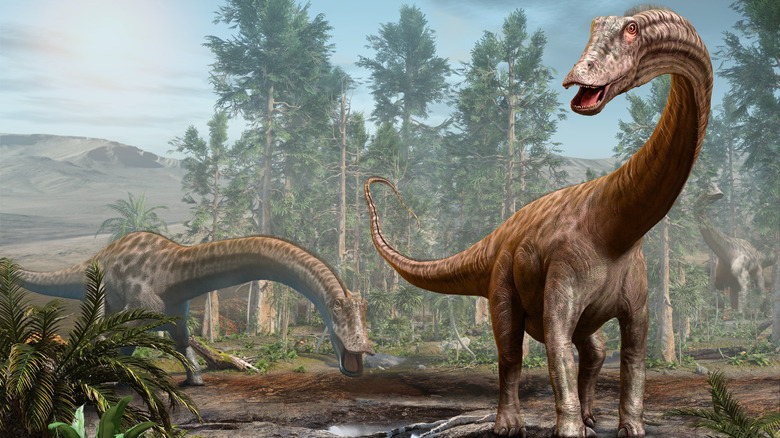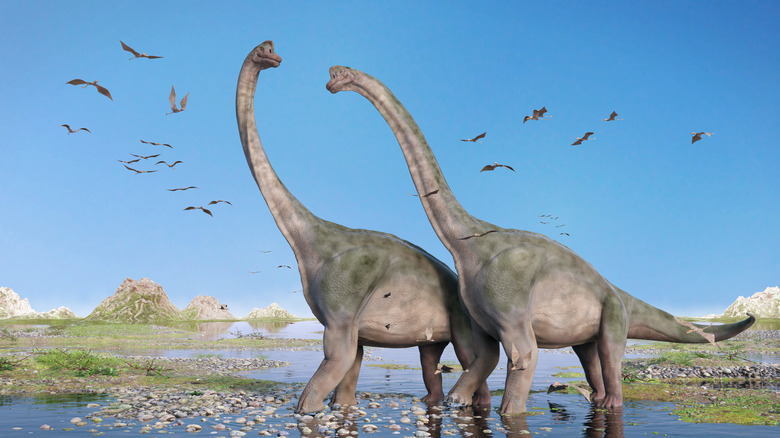Fossils Discovered In India Gave Scientists A Glimpse Into How Dinos Cared For Their Young
Based on their apparent nesting habits, certain species of sauropods in India may not have won any parent-of-the-year awards, according to research from the University of New Delhi, published on PLOS ONE. Alive during the late Jurassic through the Cretaceous period, from around 163 million to roughly 66 million years ago, and consisting of some 40 species, sauropods were the largest land animals known to have walked the Earth. At 85 feet and weighing 65 tons, the maximum size and weight of some of the biggest sauropod relatives called titanosaurs nearly rivaled those of large modern whales (via Britannica).
The University of New Delhi research was conducted from between 2017 and 2020 on a fossilized sauropod egg-laying site discovered in central India's Narmada valley. Sauropod species in general have been found on every continent except Antarctica. The sheer size and scope of what was found in the Narmada valley offered paleontologists a rare opportunity to find out more about how these colossal ancient species raised their young (via CBS News).
More than 250 egg fossils were discovered
As CBS News writes, in India's Narmada valley area, more than 90 nests and some 250 eggs fossils were discovered. Some eggs were either gathered together in clutches, as if in a nest, while other shells were found broken and scattered nearby. Certain characteristics of what was found suggest reproductive similarities to both modern-day birds and crocodiles. Some sauropod eggs in question were ovum-in-ovo, or had layers beyond just that of the shell, much like birds, while the eggs were randomly dispersed and buried in shallow pits like crocodiles.
Many different sauropod species also laid eggs in the area, behavior called colonial nesting that's seen today in modern birds and turtles. Densely gathered, colonial nesting sites give the young a strength-in-numbers fighting chance against predators. All in all, evidence gathered from the research at the Narmada valley site suggest these sauropods laid eggs in a similar manner to archosaurs, a subclass of dinosaurs sharing a common ancestor with birds and crocodiles (via Britannica).
Sauropods likely did not incubate their own eggs
As CNN notes, perhaps the most notable conclusion drawn from the Narmada valley study is that the eggs were laid too close together for the lumbering sauropods to care for them during the incubation period. The eggs would have been crushed. This alone differentiates the nesting habits of these sauropod species from those of modern-day birds and crocodiles. That the sauropod eggs were laid near water and buried shallowly suggests geothermal warmth and solar energy incubated the eggs in the parent's stead, as CBS News writes.
Of these findings, University of Calgary in Canada paleobiology expert Dr. Darla Zelenitsky told CNN, "Such nesting colonies would have been a sight to see back in the Cretaceous where the landscape would have been dotted by a huge number of large dinosaur nests." Whether the eggs were laid all at once or over the course of many thousands of years remains uncertain, according to Live Science. For this reason, it's impossible to call the area a true nesting site or simply an area sauropods found conducive to egg laying over many millennia. These sauropods were also seemingly laid sequentially — or one after the other in isolated egg-laying events — another modern bird similarity (via CNN).


